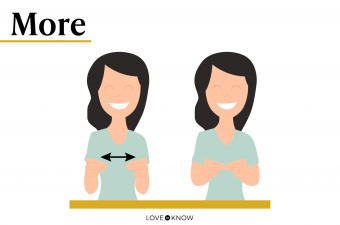
Sign language for babies is an amazing tool for bridging a big communication gap. What many parents don't realize is that your child doesn't need to have hearing issues to benefit from this form of manual communication.
If you're looking for ways to more effectively address your child's wants and needs, we detail how to start teaching baby sign language, some of the most helpful baby signs to focus on, and the advantages that this skill can bring to your child's life, and yours!
Benefits of Teaching Sign Language for Babies
Baby sign language is based on words from American Sign Language. It focuses on key words rather than the complete language, and verbal parents use a single sign rather than signing everything. Parents also articulate the word when they sign it to help little ones understand.
For the first year of your baby's life, their cries are their only form of communication. Are they hungry? Do they want more to eat? Are they tired? Basic sign language for babies is an ideal way to break down communication barriers and better understand what your child desires or requires. Think you can read your child well enough? There is also an array of other wonderful benefits from using signs.
Introducing Sign Language Early:
- Improves communication before they learn to talk
- Lowers the instance of tantrums and meltdowns
- Increases social interactions
- Betters your bonding opportunities
- Expedites the acquisition of verbal skills
- Enhances daycare and early preschool experiences
You may be thinking that kids start talking around their first birthday, so why put in the effort? The answer: language acquisition takes time. According to the Centers for Disease Control, children are now expected to have a vocabulary of 50 words by 30 months. That is well past their 12-month mark, making sign language well worth the time and effort.
When to Start Sign Language for Babies
If you want to start teaching sign language for babies, the best time to begin is around six months of age. It can take as little as a few weeks all the way up to a few months for your child to use their first sign, so the earlier you start, the better!
Also, keep in mind that fine motor skills are required to make the various signs. This means that parents can expect more progress once their child starts to show improved dexterity.
Each year, over 62,000 kids in the United States experience hearing loss after birth. This could be your child. It was MY child. He passed his initial hearing test at the hospital, but failed after he turned one. Sign language was an amazing tool that improved our communication while we waited for his tubes to be put in. He still uses it today as he builds his vocabulary at the age of three. Remember, it's never too early to start.
Tips on How to Teach a Baby Sign Language
Teaching sign language for babies is actually surprisingly simple. Use these tips to get started.
Sign Consistently
One of the main aspects of teaching babies to sign is being consistent. Consistently make the sign while you say the word and then show them the item or engage in the action. For instance, if they want milk, you will say "milk" while signing milk and then you will hand them their bottle (or start feeding them if they are too young to feed themselves).
Be Patient, Repeat, and Get on Their Level
The keys to success are repetition and patience. Over time, your child will understand that the gesture is equivalent to the word and they will suddenly start communicating with you! Remember -- you don't want to pressure them in any way.
Don't repeat the phrase over and over in one moment. Instead, get on their level, make eye contact, say the word while doing the sign, hand them the item, and then move on.
Remember It Won't Be Perfect
Another important detail for parents to keep in mind is that your child is building their fine motor skills, so their signing may not be perfect. That's okay! At this time, the purpose is to give them a way to communicate, not to become an ASL interpreter. They can fine tune these gestures later.
If you want your baby to learn sign language quickly, get creative and sign these words and phrases more often. Using the same milk scenario, parents can reiterate the milk sign by using it in the grocery store when you walk past the dairy section, when you pour it on your cereal, and even when you engage in pretend play!
More Keys to Baby Sign Language Success
For parents looking to make strides in teaching sign language for babies, also consider these helpful tips.
- Stick with teaching a few words at a time. As they catch on, build on their progress!
- Praise them regularly! You want them to be excited about their progress, so make sure to point it out.
- Continue to sign and say the words and phrases even after they know the gestures. This reinforces these signs.
Basic Sign Language for Babies: Top Nine Words to Teach
There are tens of thousands of words you can teach your child, but at this stage in life, there are a few key phrases that are probably more important than others. How did we select these choice words? They are the things your baby needs or wants the most!
Milk

This is one of the first signs that parents teach their kids because food is your baby's main requirement! Best of all, parents can use this sign to reference formula, breastmilk, or regular cow's milk.
How to Do This Sign: Pretend you are milking a cow! Make a fist, then open your hand, and repeat!
Eat

For the children who have started solid foods, this is another great sign to know. It can signal when they want a snack or are hungry for their meal.
How to Do This Sign: Press your fingers and thumbs together on one hand and bring it to your mouth.
More

This is one of my son's favorite signs to use! Whether he wants more to eat or drink, or he is hoping to snag more stickers during craft time, this is an easy way to gauge his likes and make sure he gets what he needs.
How to Do This Sign: Press your fingers and thumbs together on each hand and then tap them together repeatedly.
All Done

All done is an extremely useful sign. It is used frequently at meal times, but more importantly, my son uses it to communicate when he is overstimulated or wants to be done with an activity or interaction. This has greatly diminished the instance of meltdowns.
How to Do This Sign: Hold your hands up at chest level with your palms facing your chest. Then, turn your hands to face outward.
Pick Me Up

This simple sign helps parents know when their child wants to be held. This can signify that they are tired or that they want affection. Either way, it can be another helpful tool for stopping a meltdown from occurring.
How to Do This Sign: Simply point your index finger at the sky and raise your arm.
Poop

While the smell is typically a glaring clue that you need to change your baby's diaper, sometimes it is less noticeable when you are out and about or if you just put your baby down for a nap.
How to Do This Sign: Make a thumbs up sign with your dominant hand. Wrap your fingers from your non-dominant hand around your thumb, making a fist. Then, move your 'thumbs up hand' downward, pulling your thumb out of your fist.
Help

The Beatles said it best! We all need somebody every once in a while. This word can help you figure out that your baby needs food or a diaper change, that they dropped their pacifier, or that they want a toy.
How to Do This Sign: Hold out your non-dominant hand with your palm facing up. Then, make a thumbs up sign with your dominant hand and place it on top of your palm. Finally, tap the 'thumbs up hand' on your palm to signify that you need help.
Sleep

This is another good gesture for your child to learn because it allows them to communicate that they are tired or want a break.
How to Do This Sign: Open your hand like you are going to palm a basketball. Hold it right in front of your forehead. Then, pull your hand down to your chin. As you move your hand, bring your fingers and thumb to a point, just like you would do to make the "more" sign.
Hurt

This is the most advanced sign on our list, so it is best to wait until your child has mastered some of the other ones first. However, this is a fantastic tool for when your child feels unwell or hurt in some way.
How to Do This Sign: Make fists with both of your hands, leaving the index fingers extended outward. Point the fingers at each other and rotate them back and forth in opposite directions.
A great example of how this sign can be helpful is when your child has an earache, but isn't exhibiting symptoms. This allows your child to signal to you that something is wrong, making a timely diagnosis possible.
Sign Language for Babies Is a Stepping Stone to Speech
Many people worry that signing will hinder their child's ability to talk. This is not the case. In fact, it is the exact opposite! Research shows that teaching your baby sign language can actually help them to talk sooner! Just make sure that you continue to verbalize the names of items and your actions while your baby is learning as well as after they have mastered these signs.







